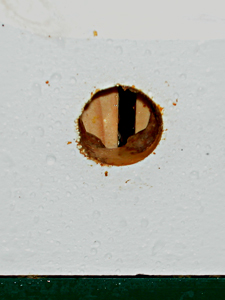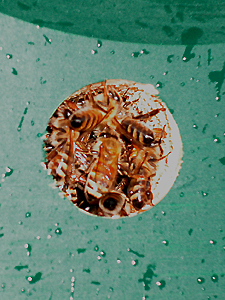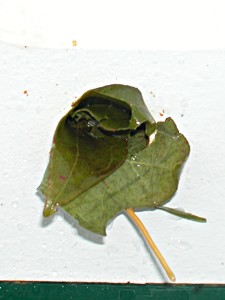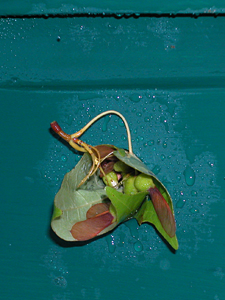 While working here today, the rain gauge on the roof informed me that today, September first, we have just received twice as much rain as we did during the entire month of August. Far from using this as an (admittedly tempting) opportunity to kvetch about the weather, I'd like to thank you intrepid urban gardeners out there...the ones who planted salvia, chives, lavender, Russian sage, crepe myrtle, augustache, Japanese Pagoda trees, and those few other late-summer bloomers that offer up nectar and life to the bees. And even more, who water them more per acre than any farmer could.
While working here today, the rain gauge on the roof informed me that today, September first, we have just received twice as much rain as we did during the entire month of August. Far from using this as an (admittedly tempting) opportunity to kvetch about the weather, I'd like to thank you intrepid urban gardeners out there...the ones who planted salvia, chives, lavender, Russian sage, crepe myrtle, augustache, Japanese Pagoda trees, and those few other late-summer bloomers that offer up nectar and life to the bees. And even more, who water them more per acre than any farmer could.  The wind has been whipping fiercely, too (over 30 MPH around 3 PM), so I went up to look at the girls, and this is where today's pictures come from. You may remember that I drilled extra entrance/exit and ventilation holes in many of my hive boxes to spare the girls extra work in coming, going, and cooling the hive. When I went up to peer into the holes on the windward side today, I saw no bees, and could not even arouse a guard bee's interest by sticking in a finger. This was worrying. Checking the wall-ward side of the hive, there were the girls, mighty crowded, too. The wind was affecting them badly, and they were trying to get far from it.
The wind has been whipping fiercely, too (over 30 MPH around 3 PM), so I went up to look at the girls, and this is where today's pictures come from. You may remember that I drilled extra entrance/exit and ventilation holes in many of my hive boxes to spare the girls extra work in coming, going, and cooling the hive. When I went up to peer into the holes on the windward side today, I saw no bees, and could not even arouse a guard bee's interest by sticking in a finger. This was worrying. Checking the wall-ward side of the hive, there were the girls, mighty crowded, too. The wind was affecting them badly, and they were trying to get far from it. So I searched around the roof to find something with which to temporarily block the holes, and found wind-blown maple and sycamore leaves. The first couple of attempts, using somewhat limp leaves, resulted in near immediate removal. Then some crisper specimens arrived with a blast of rain, and the deed was done. The last picture is the leaf protecting the box with the brood nest.
So I searched around the roof to find something with which to temporarily block the holes, and found wind-blown maple and sycamore leaves. The first couple of attempts, using somewhat limp leaves, resulted in near immediate removal. Then some crisper specimens arrived with a blast of rain, and the deed was done. The last picture is the leaf protecting the box with the brood nest.However, there was still the matter of the screened bottom boards — the foundation of the hive, which features a screened area in the middle to allow even more ventilation and mite drop, to boot.
 One of my major beekeeping shortcomings is taking counts of varroa mites on a regular basis. The reason for this is not laziness (or so I think). There are two main ways to count mites, one is a mite drop onto a board slid beneath a screen bottom board, and the other is a "sugar shake," where you trap a coupla hundred bees in a mason jar with a screened lid, put in a quarter cup or so of confectioners sugar, and shake it out over a bowl of water. The sugar knocks mites off of the bees, and the water makes it easy to count them as they drop. On a board, you just put it in, wait three days, pull it out, count mites, and divide by three.
One of my major beekeeping shortcomings is taking counts of varroa mites on a regular basis. The reason for this is not laziness (or so I think). There are two main ways to count mites, one is a mite drop onto a board slid beneath a screen bottom board, and the other is a "sugar shake," where you trap a coupla hundred bees in a mason jar with a screened lid, put in a quarter cup or so of confectioners sugar, and shake it out over a bowl of water. The sugar knocks mites off of the bees, and the water makes it easy to count them as they drop. On a board, you just put it in, wait three days, pull it out, count mites, and divide by three. The sugar shake always kills a few bees, and I hate that. It is easier on them than the old "ether roll" method used to be, and it can be done in hot weather, however. The bottom boards kill no bees at all, but they reduce hive ventilation, and in hot weather that just seems mean.
But it is hot no more, and the wind today is no friend, so I placed clean boards below the screens. Then I jeopardized the family Nikon by taking snaps in the rain, and I came down to talk to you. If you are an urban gardener, please know that lots of buzzing somebodies out there are awfully glad when you wield the hose. And if you don't mind the odd chive plant blooming in your lawn, they don't either.
No comments:
Post a Comment